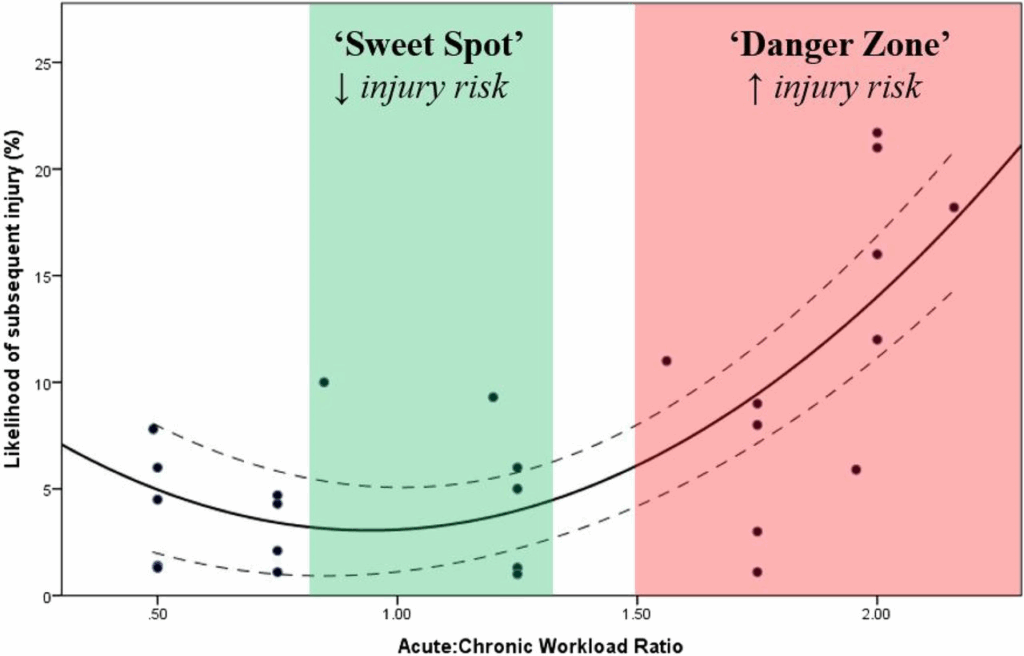Have you ever experienced a niggle or injury that’s set you back a few weeks or months? Just by monitoring and modifying your training load, you can greatly reduce the risk of these setbacks. So, let’s dive into the secrets of tweaking your training load to keep injuries at bay.
Understanding Training Load
Training load is a combination of two components: internal and external workload. The internal load is how your body responds to external stress, like measuring your heart rate or how hard you feel you’re working (rate of perceived exertion). The external load is simply the amount of work you do, such as the total distance covered, number of weights lifted, or repetitions completed (Jones et al., 2016).
No two athletes are the same. Factors like age, injury history, training background, and current physical capacity play a significant role in determining the outcome of the training load on the individual.
Consistency is Your Friend
When it comes to your training load, consistency and progressive overload is the key for injury prevention. Studies have shown that maintaining a relatively stable load, with variations between 5% to 10% increase in load compared to the previous week, keeps your risk of injury below 10%. However, if you suddenly crank up the load by 15% or more, your risk of injury skyrockets to an alarming 21%-49% in the next 7 days (Piggott et al., 2009, Gabbett, 2017) If you want to reduce your risk of injury, stick to the golden rule of gradually increasing your load by less than 10% each week.
The biggest risk to an injury is a sudden spike in training load (Gabbett, 2017 and 2020). When the training load is greater than the athlete’s current capacity, there is a risk of injury. The athlete’s current capacity changes and is impacted by mood, sleep quality, illness and stress, therefore what the athlete can tolerate today may not be tolerable tomorrow. This is why subjective and objective measures like rate of perceived exertion, heart rate and how the athlete recovers after training should be taken into consideration, when programming for the athlete to reduce the risk of injury.
Finding the Sweet Spot
Understanding the relationship between training load and injury risk is like finding the perfect harmony in a symphony. Keep in mind; that under-training can increase your risk of injury, and so too can over-training.
“… to reduce your risk of injury, stick to the golden rule of gradually increasing your load by less than 10% each week.”
Acute Chronic Workload Ratio
By calculating the Acute:Chronic Workload ratio, we can reduce the risk of injury to the athlete. The acute workload is the amount of load completed in 1 week of training, whereas chronic workload is the average workload performed in the previous 4 weeks.
Acute:Chronic Workload Ratio =
A / ((0.25x(W1 + W2 + W3 + A))
A = Acute Workload
W1, W2 and W3 = Workload in the previous 3 weeks
*Workload = Rate of perceived exertion (RPE) x session duration. For example, If I ran or weightlifted at RPE 7 for 100 minutes, my workload for the day is 700 Arbitrary units (AU).
Aim to maintain Acute:Chronic workload ratios between 0.8 and 1.3 for that sweet spot of minimized injury risk. Ratios lower than 0.8 means the training stimulus is low, increasing the risk of injury. Ratios higher than 1.5 means the athlete has too much load for the athlete’s capacity, and lands them in the “danger zone.” So, strive for balance and keep that ratio in check. (Gabbett, 2017)

Practical Tips to reduce our risk of Injury:
- Embrace Variation: Incorporate a training program that offers a high degree of variation. Mixing things up can reduce the incidence of injuries.
- Plan Ahead: Implement a well-structured and periodized training program with less than 10% increase in load per week. Planning your training cycles intelligently can work wonders in minimizing injury risks.
- Pre-season training: Remember, Rome wasn’t built in a day. Athletes who performed less than 18 weeks of pre-season training before their first injury were 9x more likely to sustain a subsequent injury! (Gabbett, 2017) Take your time and allow your body to adapt.
- Balance is Key: Avoid the perils of over-training or under-training. Strive for an acute:chronic workload ratio between 0.8 – 1.3 where your training load elicits improvement without pushing you into the danger zone.
References:
- Jones, C.M., Griffiths, P.C. and Mellalieu, S.D. (2016) ‘Training load and fatigue marker associations with injury and illness: A systematic review of longitudinal studies’, Sports Medicine, 47(5), pp. 943–974. doi:10.1007/s40279-016-0619-5.
- Piggott, B., Newton, M. and Mcguigan, M. (2009) ‘The relationship between training load and incidence of injury and illness over a pre-season at an Australian Football League Club’, Journal of Australian Strength and Conditioning, 17(3).
- Gabbett, T. (2017) ‘Infographic: The Training–Injury Prevention Paradox: Should Athletes be training smarter and harder?’, British Journal of Sports Medicine, 52(3), pp. 203–203. doi:10.1136/bjsports-2016-097249.
- Gabbett, T.J. (2020) ‘The training-performance puzzle: How can the past inform future training directions?’, Journal of Athletic Training, 55(9), pp. 874–884. doi:10.4085/1062/6050.422.19.